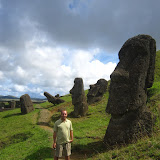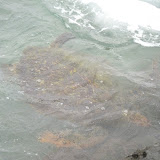Rapa Nui, the name for the island in the local Polynesian dialect (called Rapanui), which is spoken by the native people (also called Rapanui) is an enchanting place.First off, the setting is unreal. The island is the most isolated inhabited place in the world. The closest airport is Santiago, and that's a five hour flight. You can drive right along the coast until you find your way back to the same place (within only an hour or two), you will never see anything but ocean out one side. My friend Mark, a Dubliner I met on the island, noted that you could easily see how the island's original inhabitants might have thought their little island was the entire world.
Easter Island was formed by several underwater volcanoes erupting together, leaving over 100 volcanoes, craters, vents and the like above ground. Three major volcanoes, all extinct, have spectacularly beautiful crater lakes at the top. The ancient lava flows also created a number of natural caves, many of which housed native Rapa Nui for over 1,000 years, and as recently as the 1950s. The culture of the island had actually already been decimated by warfare and rapid population growth before Europeans first found it in the 18th century. Many people lived in caves for protection, hiding from rival groups and even cannibals. These days, one can go into several of the caves and look around, contemplating an existence so completely different from our own. Amusingly enough, the two caves that I visited with Mark and his girlfriend Sarah had architectural features that would make them highly sought after in the New York real estate market. One had two windows out of a cliff, looking out onto the ocean. The other had several openings in the ceilings--skylights, if you will--which enabled vegetable gardens. Crawling into the first of the two, the Caverna de las dos Ventanas, was a bit claustrophobic at first, but well worth it once we got to see the view from the living room.
Rapa Nui may not have an abundance of megafauna to compare with, say, Patagonia or the Galapagos, but it's far from a barren wasteland. There are falcons everywhere. You cannot drive along a road without seeing several hanging out on fenceposts, or zipping past your driver-side window. Along the coast one sees frigate birds, which are enormous and majestic. By far the best thing I got to see, however, was a family of sea turtles who came up to the beach to feed on fish. My sister-in-law Shirley wouldn't agree with me (she thinks, accurately I'll confess, that turtles look like old men), but they were majestic and beautiful, and fascinating to watch.
The main draw of the island is, of course, its archaelogy. The moai are absolutely enormous--generally about 3-5 times my height, and weighing as much as 100 tons. Historically, they stood on ahu--stone altars that were usually built along the coastline. The moai faced inland to watch over the people and protect them. Many of the moai also have pukao, which are red hat-like stones that are believed to represent a fashionable hairstyle from the time. Over time, the warfare that wiped out most of the population combined with the occasional natural disaster to topple all of the moai from their perches. These days some 40 or so moai have been restored to their original positions.
Although a decent amount is known about how the moai were made--they were cut from the volcanic rock at Rano Raraku volcano--and they were apparently hoisted to their platforms over several days with ramps made from logs, no one knows how they were moved from the site of their construction to their locations on the ahu. In some cases they were moved as far as 10 miles, so this particular mystery is a truly impressive one. Perhaps as impressive is the fact that some 320 moai were under construction at Rano Raraku (known as the "nursery") at the time construction was ceased. The nursery is the site of most of the largest moai ever made, as well as most of the iconic images of Rapa Nui, with the heads of various moai sticking out of the ground, the torsos buried below while the faces were detailed.
An additional feature of interest is the cult of the bird man, believed to be the deity responsible for bringing bird life to the island, which happened many years after the arrival of people. There are a number of petroglyphs around, many of them featuring the birdman. The major annual ritual of the cult involved a swimming race to a rocky crag three kilometers off shore to search for the eggs of the sooty tern. The first man to return with an egg would be crowned bird man for the following year.
The bird man cult, it's worth noting, is from the last few hundred years. And that highlights one of the island's most intriguing characteristics: although the moai look as old as time itself, and have the feel of ancient mysteries, the entire Rapanui culture is barely a thousand years old. They are certainly old, but while the moai were being built, for example, Europe was experiencing the rennaissance and exploring the globe. In Asia, meanwhile, Genghis Khan was conquering civiliations and repopulating the entire planet with his own DNA. But Rapa Nui was still literally living in the Stone Age. I don't meant this as an insult of the Rapanui culture--which has some beautiful songs and dances, and which obviously pulled off some remarkable feats. Rather I mean to highlight the force of extreme isolation with which the Rapanui had to contend. Stranded so far away from the rest of the world, and facing the dilemma of an increasing population fighting for decreasing resources, it's no wonder that so many people were lost, taking so much history with them.
So, quite simply, Easter Island is a fascinating and multifaceted jewel dropped into the middle of the ocean. It's a place that makes you ponder deep questions like the vastness of the planet and the ephemeral nature of civilizations, and it gives you an idyllic environment in which to do so--with a plentiful supply of delicious fish to make it all a little easier to handle. By the time I post this, I will have landed back in Buenos Aires, having left behind what felt a bit like a three-day dream. On Saturday I'm off to Guayaquil, Ecuador, before continuing on to the Galapagos on Sunday to begin the final portion of my journey. It's hard to believe I'm so close to the finish line, but I'm thrilled that Rapa Nui has made it clear just how much I can still be enthralled and amazed by the world around me.
Saludos,
Seth
*If you're like me, the moai conjure up images of both Marty Sherman's classmate on The Critic, or some bad guys from Super Mario Land for Gameboy. But
Fotografía:














"*If you're like me, the moai conjure up images of both Marty Sherman's classmate on The Critic, or some bad guys from Super Mario Land for Gameboy. But you're probably not like me."
ReplyDeleteUm...
There. Better?
ReplyDeleteActually, yes. Also, from Shirley:
ReplyDelete"I can't comment because I don't have a blogger account and I don't want to make one, but thanks for the shout out. I'm glad you are beginning to understand why turtles are creepy and the spawn of the devil. I miss you, brother-in-law."
Oh my god, I married my mother.
Enjoying the comment thread. Comedy clearly runs in the family.
ReplyDeleteYour post makes me want to go to Easter Island -- partly because it's so much like Hawai'i (another contender for most isolated inhabited place) and partly because it's so different in some ways. Looks like you had a great trip there. Cannot wait to hear about the Galapagos. After we talked to you in Buenos Aires you gave me a terrible travel bug. We're off to Mendoza this weekend.